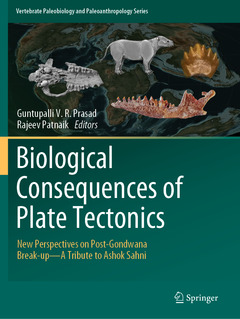Biological Consequences of Plate Tectonics, 1st ed. 2020 New Perspectives on Post-Gondwana Break-up–A Tribute to Ashok Sahni Vertebrate Paleobiology and Paleoanthropology Series
Coordonnateurs : Prasad Guntupalli V.R., Patnaik Rajeev

Dr. Guntupalli V.R. Prasad received his Ph.D. from Panjab University, Chandigarh in the year 1986. He is a former Professor at the University of Jammu and Indian Institute of Science Education & Research (Kolkata). He is presently a Professor in the Department of Geology, University of Delhi, India. Prof. Prasad has more than 34 years teaching experience at Graduate and undergraduate level. A vertebrate paleontologist by training, he has been working for the last three and half decades on the evolution of Mesozoic vertebrates of India using form and function of vertebrate fossils. Prasad’s research has focused primarily on biodiversity changes during the time span of Deccan volcanismwhich brought many new species of fishes, amphibians, reptiles and mammals to light and also provided paleontological constraints on the age of initiation and duration of Deccan Volcanism. His research has also thrown light on faunal dispersals and biogeographic linkages between the physically isolated and rapidly northward drifting Indian plate and other landmasses. Dr. Prasad’s findings of diverse mammalian groups from the Jurassic and Cretaceous of India have firmly placed India on Mesozoic mammalian map of the world. Author of more than 100 scientific papers published in leading journals in his field of specialization as well as high impact journals like Nature, Science, Nature Communications, and Proceedings of National Academy of Sciences, Prof. Prasad received Shanti Swarup Bhatnagar Prize, India’s highest science award, for his outstanding contributions in the field Vertebrate Paleontology. Other recognitions received by Prof. Prasad include J.C.Bose National Fellowship, National Geoscience Award, L. Rama Rao Birth Centenary Award, and National Award in Geosciences & Technology. He has been honored with the Fellowship of the Indian National Science Academy (FNA), Indian Academy of Sciences (FASc.), National Academy of Sciences (FNASc.), and Academy of
Acknowledges and celebrates the contributions of leading India vertebrate paleontologist Dr. Ashok Sahni
Explores biodiversity changes, evolutionary patterns, and changes in physical environments and climate due to shifting plate tectonics
Describes the role of plate tectonics in shaping the Indian climate
Discusses the paleobiogeographic history of India, including collision tectonics and biodiversity implications
Date de parution : 11-2021
Ouvrage de 432 p.
21x27.9 cm
Disponible chez l'éditeur (délai d'approvisionnement : 15 jours).
Prix indicatif 126,59 €
Ajouter au panierDate de parution : 11-2020
Ouvrage de 432 p.
21x27.9 cm
Disponible chez l'éditeur (délai d'approvisionnement : 15 jours).
Prix indicatif 126,59 €
Ajouter au panier


